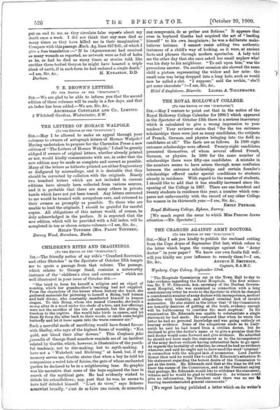CHELDREN'S RITES AND IMAGININGS.
(TO THE EDITOR OF THE "SPECTATOR.")
3in,—The friendly notice of my wife's "Cranford Souvenirs, and other Sketches" in the Spectator of October 13th tempts me to quote a passage from that volume. The passage, which relates to George Sand, contains a noteworthy instance of the "children's rites and ceremonies" which are well illustrated in your issue of October 6th :—
" She tried to form for herself a religion and an object of worship, which her grandmother's teaching had not supplied. From the characters of the heroes whose history she knew, she gathered materials for picturing to herself a Being, half human and half divine, who constantly manifested himself in human shapes. To this Being, whom she named Corambe, she built a mossy altar in a wood under the shade of a tree, and her offerings were not the sacrifice of the life of animals, but the giving of freedom to the captive. She would take birds in snares, and let them fly from the altar back to their woods, or catch some bright butterfly and let it loose again into the warm summer air."
Such a merciful mode of sacrificing would have found favour with Shelley, who says of the highest forms of worship : "Not gold, not blood their altar dowers." This Confessio fedei juvenilia of George Sand somehow reminds me of an incident related by Goethe, which, however, is illustrative of the youth- ful tendency, not to rite-making, but to myth-making. I have not a " Wahrheit und. Dichtung " at hand, but, if my
memory serves me, Goethe states that when a boy he told his companions a weird tale of fairies, the gate of whose enchanted garden he declared to be in a neighbouring lane. So graphic was his narrative that some of the boys explored the lane in search of the mythical gate. He had evidently wished to delude his schoolfellows; nay, poet that he was, he seems to have half deluded himself. " L'art de vivre," says Scherer somewhat broadly, " &est de se faire une raison, de souscrire aux compromis, de se preter aux fictions." It appears that even in boyhood Goethe had acquired the art of "lending himself" to his own imaginings; he was a deliberate make. believer betimes. -I cannot- resist adding two authentic instances of a child's way of looking, as it were, at ancient facts and phrases through modern spectacles. A lady told me the other day that she once asked her small nephew what was his duty to his neighbour. "To call upon him," was the precocious answer. On another occasion she showed the same child a picture representing the widow and her mite: the small coin was being dropped into a long hole, such as would now be called a slot. "I suppose," said the urchin, "she'll get some chocolate" I—I am, Sir, &c.,






































 Previous page
Previous page